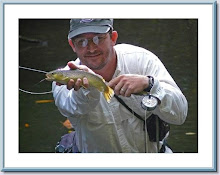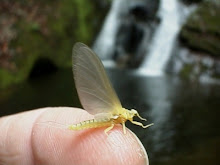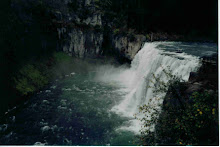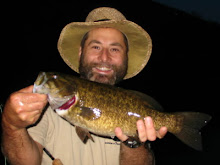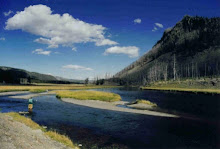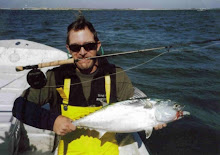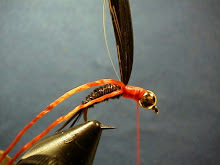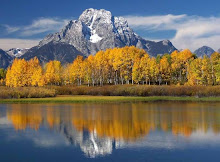
"90 % of the game is half mental..." -Yogi Berra
Much of what I do and teach others to do is to think through problems on the water and find solutions. When I got into guiding years ago it didn't take me long to figure out that perfect days were few and far between...and for me to be consistently successfully in putting clients and fish and putting landed fish in the net I was going to have to learn to adapt. To think, to think ahead, and to learn the finer points of presentation.....which by the way, is the entirety of what we do the moment we beginning putting on gear. It includes our gear, casting, our knowledge (and study off the water), observation, practice, fly tying (if you do that), .....simply put its everything that contributes to a landed fish in the net.
Over the season I often make notes and write down ideas as they come to mind. Its winter and a good time to polish basic skills, so here are a few notes I have made over the years that have helped me become a better fly angler and guide. Hopefully you will find some helpful tips here as well....some are well developed ideas, some are still developing, still others are in the 'rambling' stage. But so it is......and hope it helps you greatly enjoy your time astream.
Notes From My Guidelog:
Size Matters The fly size when matching a hatching insect is of paramount importance, and ignoring it will likely get you some lonely drifts through water that is teeming with feeding trout....in other words... if you want that large brown trout rising in front of you to show you some love, make sure your bug is the right size. Here's a tip that works for me-- - capture a natural insect and make a note of or measure its body size in millimeters. To do this, you can put a business card in your vest and a Black Sharpie Pen. Then, take the captured fly, lay it on the card, and with a line mark each end of the body. You now have the exact length, which you can then take home and use a metric ruler to determine the body length. Once you know the body length, make note of it in your fishing log, along with the stream the bug came from, the date, all other pertinent information, etc. From this point on whether you are tying or buying your flies you now have a rule of measure that will help you select the proper size.
Be Extra Observant I love Yogi Berra and his famous statements of obvious facts....but he gets the point across. He used to say "you can observe a lot just by watchin...". Yep, I agree. But its suprising how oblivious anglers are sometimes. This sounds silly, but often what occurs on the river is that folks are more interested in casting than catching. Take times when there's a hatch, for example. What occurs during a hatch is that fish in different areas of the pool might be feeding on different stages of the fly that is hatching....if you don't observe the riseform, there's no way to tell exactly what the fish just took. One example is a cool weather hatch we have called Baetis or blue winged olives. These flies are swimmer type mayflies, and they love islands and smooth small gravel runs. Fish that station themselves in the riffles or near the riffles may only see ascending nymphs, or struggling emergers, or maybe a mix of the two. Fish positioned right or left or slightly downstream may be seeing emergers in the greatest number, while fish in the tailouts might see only a few emergers and a mix of duns and cripples (flies that are stillborn or die trying to get out of the nymphal shuck). That is one reason I believe there is no 'miracle ' fly .....otherwise we'd always be able to catch fish consistently no matter the situation and no matter the fly. And that is impossible. Don't believe this? Next time you fish a hatch or anywhere for that matter ask the handful of guys catching all the fish. My bet is that they are all using different flies.
If what you are using isn't working, and you can see fish still feeding on hatching insects, back up one life stage, change the size, or both. This is sort of playing off the point before this one, but sometimes it is the right fly, right size, but wrong stage. If you are using a dun or dry fly, try an emerger. If you are using an emerger, try a nymph or a dropper off your dry fly- -- you kind of get the gist of it. This is one technique that is very effective, mentioned by Gary Borger in his most excellent of fly fishing books entitled "Presentation" . It is in my opinion the best fly fishing book in print. If you don't have one, buy one. It is so packed with great information you won't want to put it down.
If you are using a dry fly, consider the imprint the fly makes or how the natural sits on the water. Each type of dry fly pushes a definite shape or imprint into the surface film. Consider the weight of a size 14 Hendrickson as compared to a #20 or #24 Blue Winged Olive. The Hendrickson is heavy enough to press not only its feet into the surface film, but also its body, which would mean the best fly would be one that mimics those characteristics. A comparadun, or Sparkledun, which sits low in the water with the body pressed into the surface film---would be a great choice to match a Hendrickson. The Baetis on the other hand, in a size #20 or #24 is so light that it can 'stand up' on top of the surface film and have none of its body making contact with the surface. This is why often a dun imitation like a standard BWO or Adams often works quite well when other flies fail, particularly when the fish are keying on the duns.
The profile or shape of a fly can be important also. Research has shown that trout do in fact key on the wing and the height of it. On cold days, damp, rainy days and days with high humidity often the hatched mayfly may have trouble drying their wings enough to begin flight. As a result, the fly may drift for long distances with the wings in a small clump on top of its body. When this is the case, I often switch to one of my personal favorites a short winged deer hair emerger....a deadly fly and one that customers often request when fishing over the more sophisticated trout in the VA and TN tailwater streams.
Sometimes changing the shape of the nymph pattern you are using can be effective. Crawler type mayfly nymphs (sulphurs, hendricksons, some bwos), like free-living (eruciform) caddis fly larvae, often assume a curled up posture when they drift downstream. They are curled up like the shape of the letter 'C'. We often call this the "tucked' position. They wiggle and wiggle, and then relax into this position as the current carries them along. Baetis, on the other hand, are swimmers and assume the shape of a stick much like midge pupae when they are adrift. At certain times of the year I find that certain BWO hatches the straight shanked patterns will perform two or three to one over the curved ones. I have often wondered if this isn't the reason why. If we notice it and we don't live underwater, most certainly the fish notice it. In fact, it would be enough of a difference to be a distinguishing characteristic.
Color rarely has to be exact , but it certainly never hurts. Often when we get the size right and shape right somehow the exact color becomes less of a factor. The shade (light vs dark) is probably the most important factor, and its the bottom of a mayfly that determines what color our fly should be. Occasionally, with certain hatches a general color is all that is needed. I find this with BWOs, and its the major reason why to this day I will just as quickly fish a gray pattern or an Adams if there are small blue wings hatching- --and it probably works 80-90% of the time so long as I have gotten the size and shape and stage of the insect the fish are keying on. There are instances in which I have noticed color can maybe add some 'spice' to the fly, as in the sulphurs that hatch on our local waters. Often the flies are yellow to yellow /chartreuse and also yellow/orange, and the females have eggs inside them as well. For these flies often I find an orange bodied fly works quite well even when then natural insect is obviously yellow on bottom and not orange at all. Go figure.
Though it is rarely mentioned, the way the fly behaves or moves may make a difference. Occasionally, you will find times where moving the fly, twitching it, skittering it, skating it, etc., will cause a fish to strike a fly it was previously ignoring. Sometimes the fish will show rare preferences for the fly to move a certain way. One such example is during a spinner fall, when adult mayflies are dancing about and coming down to the surface, they land and then tap the abdomen on the surface to release the packet of eggs, and occasionally the rise to this type of movement is a slashing take by a fish. Midges have a tendency at times, particularly during mating flights, to hover and buzz over the surface, to land and skitter, and buzz back and forth. And often the fish take notice and will take a small dry fly that is skated or skittered. I remember a float down the world famous South Fork of the Snake River in Idaho, perhaps the easiest dry fly fishing for large fish in the lower 48, when we fished moving our flies on purpose by our guide's instruction. I mean it was like bass fishing the banks for trout. And the end of the drift when the fly starts to drag or swing and pickup speed, that is a time that the fly gets noticed by a fish and often gets hammered. So it would be safe to assume that while we don't move our flies on purpose most of the time, there are indeed times that it might not only be warranted but also called for.
Feeding fish feed in a rythym if there's a steady supply of food or a hatch. Improve your score by timing the drift or arrival of your feathered fraud so that it coincides with when the fish was ready to eat anyway. This is a common and huge mistake on tailwaters I see.....its the one cast, two cast, then move on to another fish type of approach. The best thing is to continually cast to a feeding fish.....trying to time the drift to fit the fish's feeding rythym. On some larger fish I have presented two dozen times only to get a take on the drift when I was reading to move on. Other things worth considering it how long it takes a fish to rise. That is the time between rises plus the time it takes the fish to go from top to bottom, if you can see it. I like to observe a fish closely if its a good one, and make note of how long it takes the fish to rise, take a fly off the surface or pluck an emerger from the film, return to the bottom, and then do it all over again. The amount of time it takes for that to happen tells you how long you should wait between presentations to the fish. Our presentations are much more effective when they arrive at the exact time the fish was going to rise anyway.....which is precisely the point.
Fish often prefer to feed off to one side or the other. When you observe feeding fish make note of whether it is showing a preference in feeding off to a particular angle or side....then present the fly to that side. I have caught fish before and then discovered that they had a bad eye. Also, fish might have a dominant eye as well and prefer to feed off to one side.
Learn to recognize and mitigate drag whenever it occurs. Drag is to be avoided like the plague. There's obvious drag which you can see, and technically it is occuring whenever the fly is moving faster or slower than the current it's sitting in. Then there's micro drag, which occurs at a distance (often when dry fly fishing) and is hard to perceive in many cases. Micro drag is a primary cause of refusals on flat water with dry flies.....the flat surface makes it painfully noticeable. When nymphing, drag is just as important.....its not just a speed thing either. Drag on a nymph presentation means the fly is not able to sink or drift where it needs to be. Often folks fishing fast water or pocket water have this happen and never realize that because of drag the fish never saw the fly because it never reached bottom.....and they move on completely convinced that the fish weren't interested or there were none to be caught.....Big mistake. On guided trips we routinely fish behind other anglers all day long and catch fish by capitalizing on this.
Fish get spooked and lined far more often that we ever realize. Kirk Deeter of Field and Stream magazine once did a feature in which he stated that A lot of anglers have the necessary fishing skills to be successful but lack the necessary wading skills. I completely agree. If you walk heavily in the stream, pushing a wake ahead of you, splashing, ignoring the need to not cast shadows on the water either with your person or your fly rod- - -- then you will spook a lot of fish you would have had a chance to catch. Also, I'd have to say a straight upstream presentation not only presents a difficult line management situation but it almost guarantees that you will line the fish - that is land the line on top of the fish and with the splash, flash, and shadow the fish will spook and its game over. In my lifetime I have only seen two fly anglers who could cast so well they could fish this way to rising fish...... Finally, limit false casting....it only announces your presence to the fish.
He who chases two chickens goes home hungry. When fishing to feeding fish/rising fish, pick out one and go after that one specifically. One mistake that inexperienced and veteran anglers alike make is they get 'buck fever' and a bad case of MTS (Multiple Target Syndrome -common on the South Holston) where there are so many rises they cast here, there, everywhere and hours later have yet to catch a fish. Pick out a fish, present the fly to it. If it doesn't take, analyze what went wrong and correct it or present the fly again. If it quits feeding or spooks, then you can move on to another one. Like a game of pool, pick out fish and fish to them...and always be mindful of the 8 ball (trophy fish).
Misjudgement is a huge problem.....Misjudging the rise or location or depth if nymphing of the fish is a problem. Fish on the bottom are deeper and closer than they appear because of the principle of refraction and the way light is bent when it penetrates the surface. A rising fish will leave a ring on the surface. It takes a small amount of time for the rise ring to actually form, so the fish is often upstream of where the riseform actually appears/ occurs on the surface. The faster the current, the farther upstream the rising fish actually is....and the farther the ring on the surface will have drifted...to sum it all up a rise ring/riseform on the top drifts downstream just like your fly. This is a huge problem on tailwaters where numbers of rising fish exist. One key is to compensate a little, not a lot, cast a little farther upstream....but not too far. Cast too far and the fly drags before it reaches a fish....which is just as bad a mistake. Lead the fish a few feet but no more.
Fish and Cast Less, Rest the Water more.... This definitely applies more to tailwaters and small stream (wild fish) waters, but it is applicable anywhere. Two clients/friends who do this better than anyone I know of and is are easily the two best anglers/dry fly fishermen I have ever met are Dr. Jim Sellers and Judge Joe Craig....to watch them work rising fish is not only watching an exercise in efficiency but it is an art....and a joy to watch. Catch a fish, rest the water. Pick out another fish, calculate the strategy, present the fly. The result: still catch numbers of fish and catch the large/difficult fish no one else can catch. Its a lesson worth putting into practice...!
Fish aren't always feeding This mistake is one of those 'everytime out' mistakes. A typical scenario: its winter, I have worked all week and I can't wait to fish, so I leave home at 530am, head to the river, arrive to the river at 730am and the water is 34F, no bugs about anywhere, no obvious activity of anykind. I rig up with what I have caught fish on before. I go to a pool that I either know has fish or that I can see has fish. Cast , cast, cast, nothing. Same thing for the next two hours. And during that time every pool is like that. My conclusion? Fish aren't interested. My rig is wrong. My flies are wrong. Wrong. The problem probably is that the fish won't even be in feeding mode until 11am, right after you leave at 1030am convinced it was a bad day. They will feed from 11am til mid to late afternoon if its a nice day, then they will shut down just like they were or would have been had you arrived at 730 am and started fishing. The point: fish do things on a schedule sometimes, sometimes they get tuned in to daily hatches, sometimes they have already eaten (like a heavy hatch the day before- - -or a huge brown that ate two six inch rainbows before you showed up). The fact of the matter is sometimes they aren't feeding and there's nothing you can do about it.
Other measures to improve your score.....
Switching to a lighter tippet or a different material. If you aren't getting takes, switch to a lighter tippet or a different /less visible material such as fluorocarbon. That might mean going lighter to 6x, 7x, 8x. Learning to work a nice fish on light tippet will make you a better angler..... If you are nymphing you might switch to fluorocarbon. Whatever the case, you'll normally get more strikes on the lighter stuff. I use a product called 'Shock Gum' which is made by Rio, and its a milky white stretchy material that I tie into the leader butt. It has tons of stretch and protects light tippet when you set the hook or get into a large fish. I have had clients land 7 and 8lb fish using it on 6X material, which is no small feat.
Learn a variety of presentation casts. Learn to do a reach cast. It is the deadliest presentation cast there is for across and down and across presentations and in my opinion it is the most valuable cast in my arsenal for fishing larger waters and tailwaters. It is a presentation cast that allows the fly to go down first without the fish seeing the leader, tippet, or fly line by putting an aerial mend into the line. The mend increases the amount of time the fly drifts drag free to and over the fish. Most clients I have taught this to have noticed an immediate difference in the quality of their presentations, number of fish caught, and the number of larger, tougher, more mature and selective fish they are able to fool.
Learn to tie your own leaders. There are some good substitutes, like Rio's Classic Hand tied Leaders, but in my opinion tying your own George Harvey style leaders is the way to go. All standard fly shop leaders are built on what is called the Ritz formula or 60-20-20 (60% butt, 20% taper, 20% tippet)....which insures turnover and a nice straight leader. When drag free drifts over selective fish are the desire.....straight leader should not be a part of your vocabulary. When you are fishing to rising fish during a hatch, the last thing you want is for the leader to fully straighten out. If it does you get instant drag on the fly and the fish won't touch it. As far as I know, Frog Hair is the only company currently producing a George Harvey leader commercially. A George Harvey leader has a shorter, lighter butt which transfers less power, only enough to turn the leader over but not straighten it. The taper (middle) is tied with longer sections, and the final part is a long supple tippet. Anyone more interested in catching selective trout during a hatch will appreciate that the name of the game is getting a good cast that produces a lot of drag mitigating slack near the fly, not the rocket fast, high line speed, cast a pretty, small, tight loop game that is all too often the rave today.
Learn to Create Slack with your Casts..... Learn to throw lots of slack. The name of the game is getting good drifts, and slack is imperative if good drifts are what you are shooting for. Yes, this I even apply to nymphing. Let me go out on a limb and say that I fish nymphs a lot, I mean a whole lot, in all ways, and I abhor the tight line high stick method you see and observe so many people doing. We don't do this, or shall I say hardly ever do this, and in my opinion is a major reason people don't catch as many fish nymphing as they might. Why? One there's no slack and what is happening is they are actually creating drag by holding the rod high. Slack not only delivers a good drift but also is the reason the fly reaches bottom. It's not all weight that gets the fly down. But you say, "wait a minute, if I have all that slack I won't be able to set the hook." If you have too much slack yes that is true. But what I do and what I teach clients is proper line management - - - which includes slack in combination with mending in just the right amount. And we get consistent results , day in and day out in every conceivable stream condition.
Learn a Variety of Casts. Learn to do all types of casts----steeple casts, parachute casts, pile casts, etc, casts that make it possible to get good drifts. Many of the lessons I do for intermediate and advanced anglers, yes I said intermediate and advanced anglers--- is to teach them to throw slack and then manage it effectively. It really has very little to do with how well you can cast or fish a straight line.
Slack in the Leader is a Great Thing. Anyone more interesting in catching more trout instead of looking good will learn to put lots of slack into the leader....and sometimes doing it will look sloppy. Plenty of slack is a good thing if its in the leader, and maybe a little to no slack in the line. But the point is we are shooting for manageable slack --that is just enough that allows a natural drag free and natural presentation but that still allows for effective striking or hook setting. In my fly fishing classes, lessons, and schools, I often do a little exercise showing folks how much slack is actually manageable. I ask my students, "Does anyone believe if their leader, the entire leader, is piled up in a Dixie Cup, and they get a strike, that they could still set the hook effectively?" The answer, predictably, is usually "Of course not." The correct answer? Absolutely it is. You can pile up your entire leader in a cup, set a hook, and then connect on the hookset. Don't believe this? Give it a try. Rig up your rod, have a friend or spouse step on the fly, then pile the leader up right at their foot. Now stretch out, lets say 15-20 feet, 30 feet, whatever you like, of fly line. Now pretend you just got a strike and set the hook sharply. You will be surprised if you are like most anglers that you can still connect on the hookset. Herein lies the point.....you can do this when the slack is in the leader.
Learn a few tricks to put in your bag.....This is one where we can really get creative. One thing western spring creek guides and seasoned anglers often do is cast downstream and to the right or left of the fish, then they pull the fly upstream and into the line of drift where it will pass over the fish, then drop the rod tip which puts enough slack into the fly to get it over the fish without drag. Another trick that works well is to use some of the dry fly powders or dessicants like Doc's Dust and Frog's Fanny to create lifelike air bubbles on your nymph. Just rub a bit into the wingcase of a nymph or emerger, doing so on a subsurface fly makes an air bubble cling to the surface of the fly, exactly like what happens when a real fly comes to the surface to hatch. One last thing, which I have used a lot in both my own fishing and with clients, is to use something odd like a streamer or terrestrial or egg pattern...maybe something totally different from what you would normally use. "Hatch breakers" like terrestrials are a good example. Beetles, ants, and hoppers are such delectable treats for a trout that sometimes they'll take a terrestrial during a hatch even when they are obviously feeding on flies that are hatching. This happens a lot during mid-summer to fall blue winged olive hatches on Virginia's Smith River. I remember one past trip on the TN' South Holston when I was there with Ken and Sandy Van Hook of Pinnacle, NC. We had noticed several fish rising in the run in front of us as some sulphurs had begun to hatch. We saw a ginormous (gigantic + enormous) brown take a slashing strike at one of the 10 inch rainbows that were rising to the hatching flies. Yes, he was trying to eat that 10" rainbow. I dug out another fly box from the back pouch on my SIMMS vest, and found a 5-6" white Lefty's deceiver. We tied it on and two casts and a ten minute fight later that ginormous brown trout lay in my net.
Well, time to put some of this to work.....













